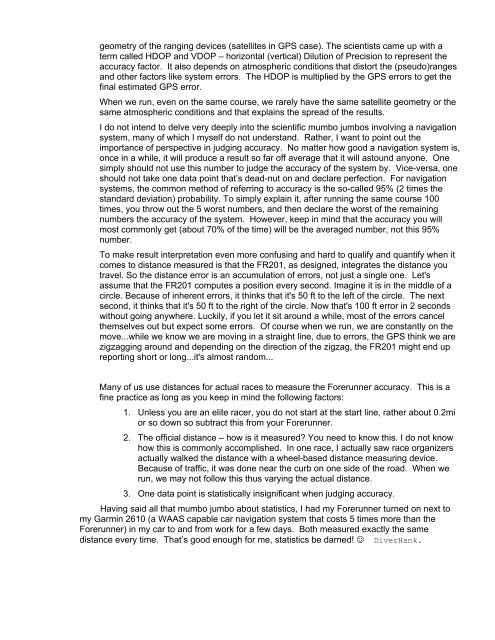Garmin Forerunner 201/Forerunner 301 ... - Penyagolosa.net
Garmin Forerunner 201/Forerunner 301 ... - Penyagolosa.net
Garmin Forerunner 201/Forerunner 301 ... - Penyagolosa.net
You also want an ePaper? Increase the reach of your titles
YUMPU automatically turns print PDFs into web optimized ePapers that Google loves.
geometry of the ranging devices (satellites in GPS case). The scientists came up with a<br />
term called HDOP and VDOP – horizontal (vertical) Dilution of Precision to represent the<br />
accuracy factor. It also depends on atmospheric conditions that distort the (pseudo)ranges<br />
and other factors like system errors. The HDOP is multiplied by the GPS errors to get the<br />
final estimated GPS error.<br />
When we run, even on the same course, we rarely have the same satellite geometry or the<br />
same atmospheric conditions and that explains the spread of the results.<br />
I do not intend to delve very deeply into the scientific mumbo jumbos involving a navigation<br />
system, many of which I myself do not understand. Rather, I want to point out the<br />
importance of perspective in judging accuracy. No matter how good a navigation system is,<br />
once in a while, it will produce a result so far off average that it will astound anyone. One<br />
simply should not use this number to judge the accuracy of the system by. Vice-versa, one<br />
should not take one data point that’s dead-nut on and declare perfection. For navigation<br />
systems, the common method of referring to accuracy is the so-called 95% (2 times the<br />
standard deviation) probability. To simply explain it, after running the same course 100<br />
times, you throw out the 5 worst numbers, and then declare the worst of the remaining<br />
numbers the accuracy of the system. However, keep in mind that the accuracy you will<br />
most commonly get (about 70% of the time) will be the averaged number, not this 95%<br />
number.<br />
To make result interpretation even more confusing and hard to qualify and quantify when it<br />
comes to distance measured is that the FR<strong>201</strong>, as designed, integrates the distance you<br />
travel. So the distance error is an accumulation of errors, not just a single one. Let's<br />
assume that the FR<strong>201</strong> computes a position every second. Imagine it is in the middle of a<br />
circle. Because of inherent errors, it thinks that it's 50 ft to the left of the circle. The next<br />
second, it thinks that it's 50 ft to the right of the circle. Now that's 100 ft error in 2 seconds<br />
without going anywhere. Luckily, if you let it sit around a while, most of the errors cancel<br />
themselves out but expect some errors. Of course when we run, we are constantly on the<br />
move...while we know we are moving in a straight line, due to errors, the GPS think we are<br />
zigzagging around and depending on the direction of the zigzag, the FR<strong>201</strong> might end up<br />
reporting short or long...it's almost random...<br />
Many of us use distances for actual races to measure the <strong>Forerunner</strong> accuracy. This is a<br />
fine practice as long as you keep in mind the following factors:<br />
1. Unless you are an elite racer, you do not start at the start line, rather about 0.2mi<br />
or so down so subtract this from your <strong>Forerunner</strong>.<br />
2. The official distance – how is it measured? You need to know this. I do not know<br />
how this is commonly accomplished. In one race, I actually saw race organizers<br />
actually walked the distance with a wheel-based distance measuring device.<br />
Because of traffic, it was done near the curb on one side of the road. When we<br />
run, we may not follow this thus varying the actual distance.<br />
3. One data point is statistically insignificant when judging accuracy.<br />
Having said all that mumbo jumbo about statistics, I had my <strong>Forerunner</strong> turned on next to<br />
my <strong>Garmin</strong> 2610 (a WAAS capable car navigation system that costs 5 times more than the<br />
<strong>Forerunner</strong>) in my car to and from work for a few days. Both measured exactly the same<br />
distance every time. That’s good enough for me, statistics be darned! ☺ DiverHank.


